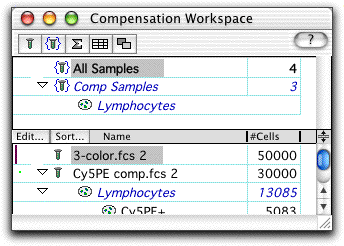
gs_pop_get_data(gs) # Error in y): gate is not parsed! Otherwise it will display the value computed from FCS file, which will be NA in this case since we didn’t load FCS files.Īpparently, it is very fast to only import xml, but data won’t be available for retrieving. Note that xml flag needs to be set in order to tell it to return the stats from xml file. # stop("'deriv' must be between 0 and 3")Īnd stats head(gs_pop_get_stats(gs, xml = TRUE)) # sample pop count Transformations gh_get_transformations(gs], channel = "B710-A") # function (x, deriv = 0) # Compensation object 'defaultCompensation': # Ellipsoid gate 'CD3+' in dimensions and SSC-AĬompensations gs_get_compensations(gs) # $CytoTrol_CytoTrol_1.fcs_119531

Since compensation is a statistical calculation, the more data collected, the more accurate the compensation will be.Īs shown in this data below, as the number of collected events increases, the compensation values move towards the actual compensation value.It is possible to only import the gating structure without reading the FCS data by setting execute flag to FALSE. Step 2: Collect the data and make sure there is a sufficient number of events.Īfter staining the carrier, it’s time to collect the compensation controls. Often times, staining the beads with 1/2 to 1/10 the concentration used on the cells will keep the signal on-scale, while keeping the signal above that of the cells that the compensation is to be applied to. Instead, simply re-stain the beads with less antibody. When this happens, do NOT turn down the voltage to bring the signal on-scale. Very often, compensation beads are stained with too much antibody and as a result, the fluorescent signal goes off-scale. Conversely, the amount of antibody the beads are stained with is less critical. The biggest concern with preparing proper compensation controls is that the fluorescence intensity of the controls must be at least as bright as that of the cells that the compensation will be applied to. However, beads cannot be used for some dyes, like viability dyes (such as PI, 7AAD, DAPI), fluorescent proteins, and other protein reporters (redox dyes, JC1, Ca++ dyes). Autofluorescence is not a factor since all the beads have the same autofluorescence values.Clear positive and negative signals show up on your control plots.This results in the brightest signal possible for your controls. All the antigen is captured in your solutions, not just some of it.


Flowjo 10 manual compensation software#
The best practices for compensation involve following some very specific rules.These best practices also involve the use of automatic compensation protocols that are available in all major data analysis software packages. 4 Steps To Compensating A 4-Color Experiment Without knowing the median fluorescent intensity of the positives in the negative channel, or being able to evaluate the spread of the data, it is impossible to determine which of these above plots display the properly compensated values.


 0 kommentar(er)
0 kommentar(er)
